Employee Satisfaction's Role in Shaping Brand Reputation & Culture
VerifiedAdded on 2023/06/12
|7
|1597
|361
Essay
AI Summary
This essay explores the critical role of employee satisfaction in shaping an organization's brand reputation and internal culture. It argues that satisfied employees are more likely to be engaged, productive, and loyal, leading to a stronger company culture and a positive external image. Conversely, dissatisfied employees can damage a company's reputation through poor performance and negative word-of-mouth. The essay examines how employee satisfaction influences various aspects of organizational life, including employee retention, performance levels, and the willingness to go the extra mile. Ultimately, the essay concludes that prioritizing employee satisfaction is essential for building a successful and reputable organization.
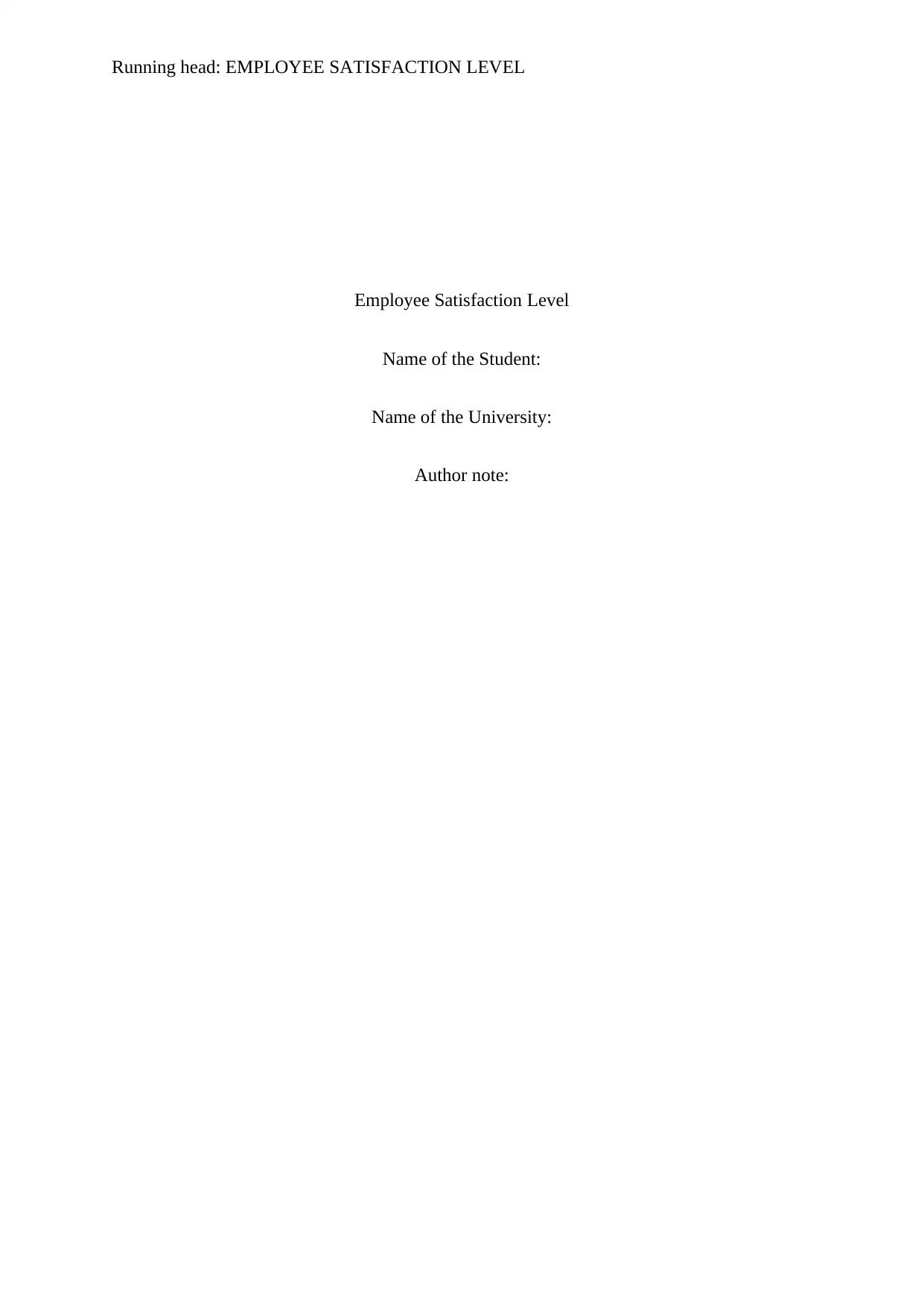
Running head: EMPLOYEE SATISFACTION LEVEL
Employee Satisfaction Level
Name of the Student:
Name of the University:
Author note:
Employee Satisfaction Level
Name of the Student:
Name of the University:
Author note:
Paraphrase This Document
Need a fresh take? Get an instant paraphrase of this document with our AI Paraphraser
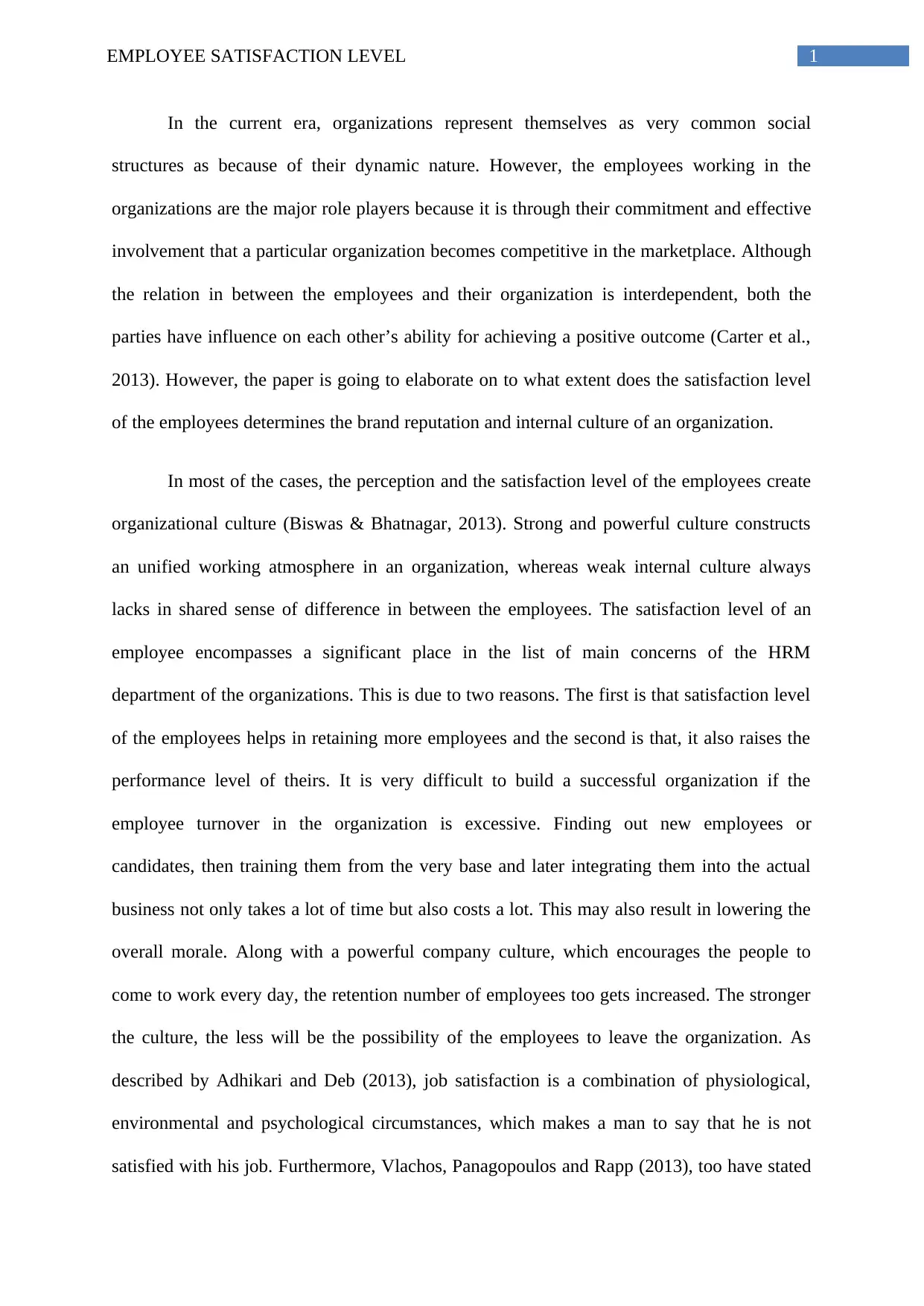
1EMPLOYEE SATISFACTION LEVEL
In the current era, organizations represent themselves as very common social
structures as because of their dynamic nature. However, the employees working in the
organizations are the major role players because it is through their commitment and effective
involvement that a particular organization becomes competitive in the marketplace. Although
the relation in between the employees and their organization is interdependent, both the
parties have influence on each other’s ability for achieving a positive outcome (Carter et al.,
2013). However, the paper is going to elaborate on to what extent does the satisfaction level
of the employees determines the brand reputation and internal culture of an organization.
In most of the cases, the perception and the satisfaction level of the employees create
organizational culture (Biswas & Bhatnagar, 2013). Strong and powerful culture constructs
an unified working atmosphere in an organization, whereas weak internal culture always
lacks in shared sense of difference in between the employees. The satisfaction level of an
employee encompasses a significant place in the list of main concerns of the HRM
department of the organizations. This is due to two reasons. The first is that satisfaction level
of the employees helps in retaining more employees and the second is that, it also raises the
performance level of theirs. It is very difficult to build a successful organization if the
employee turnover in the organization is excessive. Finding out new employees or
candidates, then training them from the very base and later integrating them into the actual
business not only takes a lot of time but also costs a lot. This may also result in lowering the
overall morale. Along with a powerful company culture, which encourages the people to
come to work every day, the retention number of employees too gets increased. The stronger
the culture, the less will be the possibility of the employees to leave the organization. As
described by Adhikari and Deb (2013), job satisfaction is a combination of physiological,
environmental and psychological circumstances, which makes a man to say that he is not
satisfied with his job. Furthermore, Vlachos, Panagopoulos and Rapp (2013), too have stated
In the current era, organizations represent themselves as very common social
structures as because of their dynamic nature. However, the employees working in the
organizations are the major role players because it is through their commitment and effective
involvement that a particular organization becomes competitive in the marketplace. Although
the relation in between the employees and their organization is interdependent, both the
parties have influence on each other’s ability for achieving a positive outcome (Carter et al.,
2013). However, the paper is going to elaborate on to what extent does the satisfaction level
of the employees determines the brand reputation and internal culture of an organization.
In most of the cases, the perception and the satisfaction level of the employees create
organizational culture (Biswas & Bhatnagar, 2013). Strong and powerful culture constructs
an unified working atmosphere in an organization, whereas weak internal culture always
lacks in shared sense of difference in between the employees. The satisfaction level of an
employee encompasses a significant place in the list of main concerns of the HRM
department of the organizations. This is due to two reasons. The first is that satisfaction level
of the employees helps in retaining more employees and the second is that, it also raises the
performance level of theirs. It is very difficult to build a successful organization if the
employee turnover in the organization is excessive. Finding out new employees or
candidates, then training them from the very base and later integrating them into the actual
business not only takes a lot of time but also costs a lot. This may also result in lowering the
overall morale. Along with a powerful company culture, which encourages the people to
come to work every day, the retention number of employees too gets increased. The stronger
the culture, the less will be the possibility of the employees to leave the organization. As
described by Adhikari and Deb (2013), job satisfaction is a combination of physiological,
environmental and psychological circumstances, which makes a man to say that he is not
satisfied with his job. Furthermore, Vlachos, Panagopoulos and Rapp (2013), too have stated
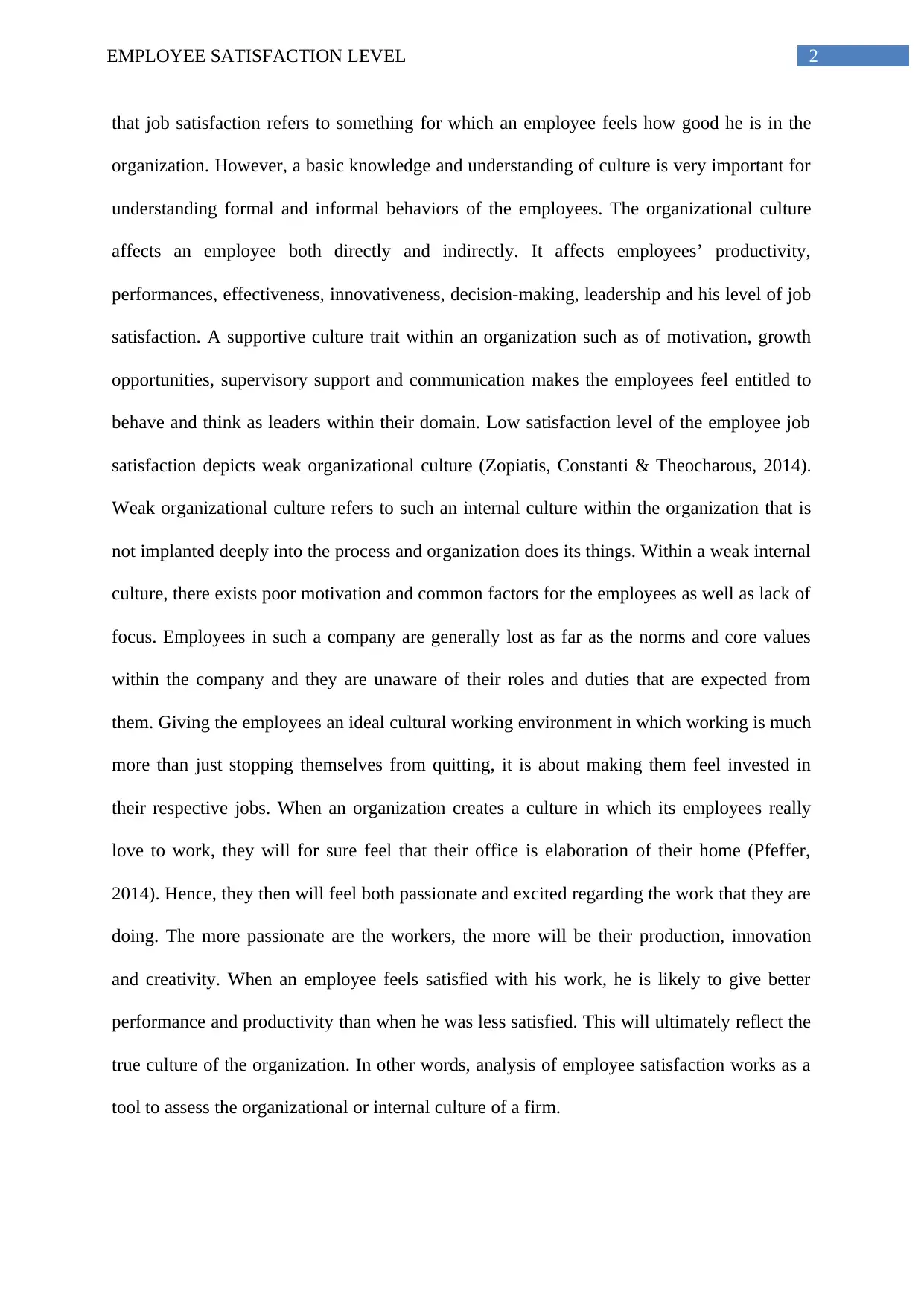
2EMPLOYEE SATISFACTION LEVEL
that job satisfaction refers to something for which an employee feels how good he is in the
organization. However, a basic knowledge and understanding of culture is very important for
understanding formal and informal behaviors of the employees. The organizational culture
affects an employee both directly and indirectly. It affects employees’ productivity,
performances, effectiveness, innovativeness, decision-making, leadership and his level of job
satisfaction. A supportive culture trait within an organization such as of motivation, growth
opportunities, supervisory support and communication makes the employees feel entitled to
behave and think as leaders within their domain. Low satisfaction level of the employee job
satisfaction depicts weak organizational culture (Zopiatis, Constanti & Theocharous, 2014).
Weak organizational culture refers to such an internal culture within the organization that is
not implanted deeply into the process and organization does its things. Within a weak internal
culture, there exists poor motivation and common factors for the employees as well as lack of
focus. Employees in such a company are generally lost as far as the norms and core values
within the company and they are unaware of their roles and duties that are expected from
them. Giving the employees an ideal cultural working environment in which working is much
more than just stopping themselves from quitting, it is about making them feel invested in
their respective jobs. When an organization creates a culture in which its employees really
love to work, they will for sure feel that their office is elaboration of their home (Pfeffer,
2014). Hence, they then will feel both passionate and excited regarding the work that they are
doing. The more passionate are the workers, the more will be their production, innovation
and creativity. When an employee feels satisfied with his work, he is likely to give better
performance and productivity than when he was less satisfied. This will ultimately reflect the
true culture of the organization. In other words, analysis of employee satisfaction works as a
tool to assess the organizational or internal culture of a firm.
that job satisfaction refers to something for which an employee feels how good he is in the
organization. However, a basic knowledge and understanding of culture is very important for
understanding formal and informal behaviors of the employees. The organizational culture
affects an employee both directly and indirectly. It affects employees’ productivity,
performances, effectiveness, innovativeness, decision-making, leadership and his level of job
satisfaction. A supportive culture trait within an organization such as of motivation, growth
opportunities, supervisory support and communication makes the employees feel entitled to
behave and think as leaders within their domain. Low satisfaction level of the employee job
satisfaction depicts weak organizational culture (Zopiatis, Constanti & Theocharous, 2014).
Weak organizational culture refers to such an internal culture within the organization that is
not implanted deeply into the process and organization does its things. Within a weak internal
culture, there exists poor motivation and common factors for the employees as well as lack of
focus. Employees in such a company are generally lost as far as the norms and core values
within the company and they are unaware of their roles and duties that are expected from
them. Giving the employees an ideal cultural working environment in which working is much
more than just stopping themselves from quitting, it is about making them feel invested in
their respective jobs. When an organization creates a culture in which its employees really
love to work, they will for sure feel that their office is elaboration of their home (Pfeffer,
2014). Hence, they then will feel both passionate and excited regarding the work that they are
doing. The more passionate are the workers, the more will be their production, innovation
and creativity. When an employee feels satisfied with his work, he is likely to give better
performance and productivity than when he was less satisfied. This will ultimately reflect the
true culture of the organization. In other words, analysis of employee satisfaction works as a
tool to assess the organizational or internal culture of a firm.
⊘ This is a preview!⊘
Do you want full access?
Subscribe today to unlock all pages.

Trusted by 1+ million students worldwide
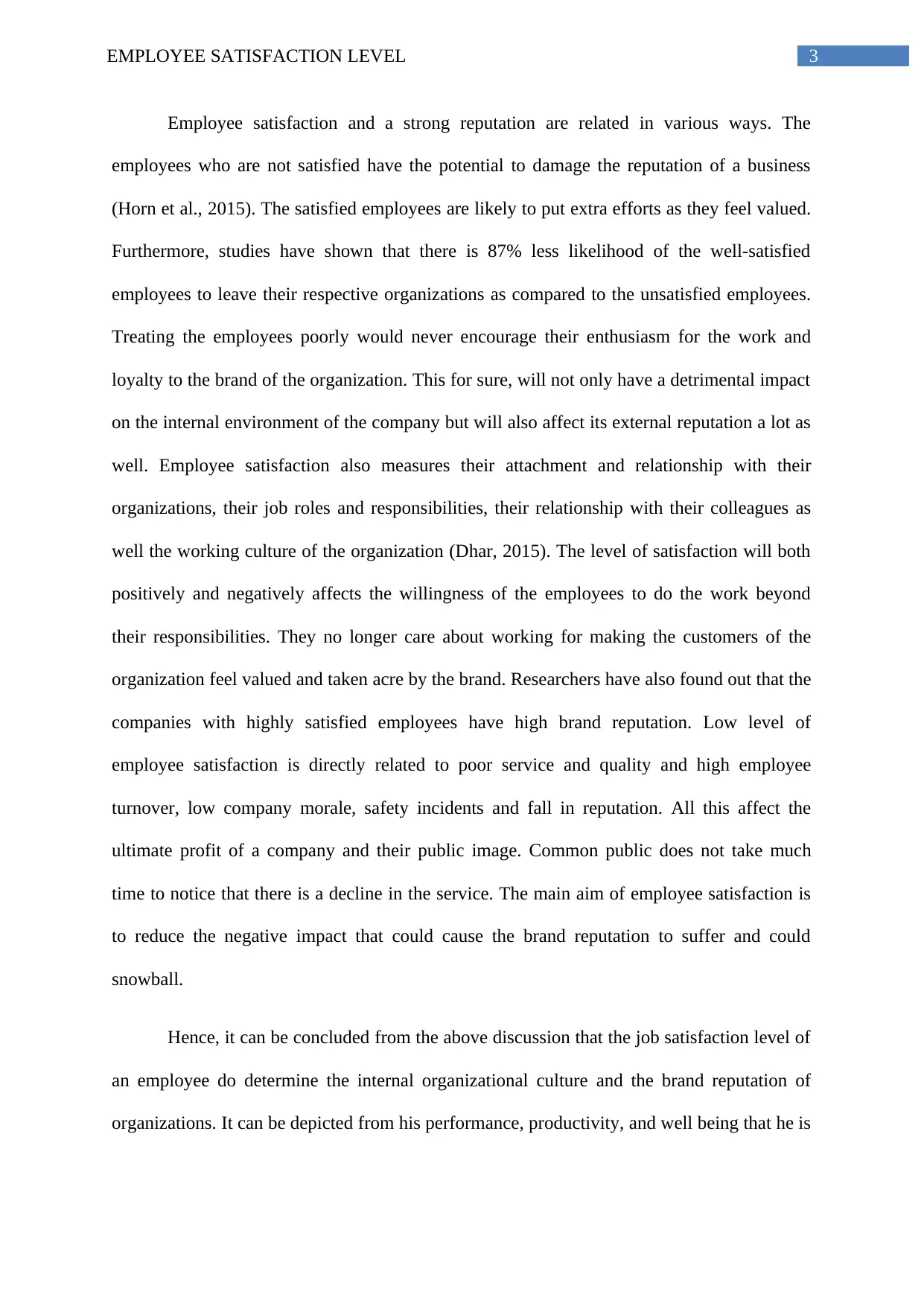
3EMPLOYEE SATISFACTION LEVEL
Employee satisfaction and a strong reputation are related in various ways. The
employees who are not satisfied have the potential to damage the reputation of a business
(Horn et al., 2015). The satisfied employees are likely to put extra efforts as they feel valued.
Furthermore, studies have shown that there is 87% less likelihood of the well-satisfied
employees to leave their respective organizations as compared to the unsatisfied employees.
Treating the employees poorly would never encourage their enthusiasm for the work and
loyalty to the brand of the organization. This for sure, will not only have a detrimental impact
on the internal environment of the company but will also affect its external reputation a lot as
well. Employee satisfaction also measures their attachment and relationship with their
organizations, their job roles and responsibilities, their relationship with their colleagues as
well the working culture of the organization (Dhar, 2015). The level of satisfaction will both
positively and negatively affects the willingness of the employees to do the work beyond
their responsibilities. They no longer care about working for making the customers of the
organization feel valued and taken acre by the brand. Researchers have also found out that the
companies with highly satisfied employees have high brand reputation. Low level of
employee satisfaction is directly related to poor service and quality and high employee
turnover, low company morale, safety incidents and fall in reputation. All this affect the
ultimate profit of a company and their public image. Common public does not take much
time to notice that there is a decline in the service. The main aim of employee satisfaction is
to reduce the negative impact that could cause the brand reputation to suffer and could
snowball.
Hence, it can be concluded from the above discussion that the job satisfaction level of
an employee do determine the internal organizational culture and the brand reputation of
organizations. It can be depicted from his performance, productivity, and well being that he is
Employee satisfaction and a strong reputation are related in various ways. The
employees who are not satisfied have the potential to damage the reputation of a business
(Horn et al., 2015). The satisfied employees are likely to put extra efforts as they feel valued.
Furthermore, studies have shown that there is 87% less likelihood of the well-satisfied
employees to leave their respective organizations as compared to the unsatisfied employees.
Treating the employees poorly would never encourage their enthusiasm for the work and
loyalty to the brand of the organization. This for sure, will not only have a detrimental impact
on the internal environment of the company but will also affect its external reputation a lot as
well. Employee satisfaction also measures their attachment and relationship with their
organizations, their job roles and responsibilities, their relationship with their colleagues as
well the working culture of the organization (Dhar, 2015). The level of satisfaction will both
positively and negatively affects the willingness of the employees to do the work beyond
their responsibilities. They no longer care about working for making the customers of the
organization feel valued and taken acre by the brand. Researchers have also found out that the
companies with highly satisfied employees have high brand reputation. Low level of
employee satisfaction is directly related to poor service and quality and high employee
turnover, low company morale, safety incidents and fall in reputation. All this affect the
ultimate profit of a company and their public image. Common public does not take much
time to notice that there is a decline in the service. The main aim of employee satisfaction is
to reduce the negative impact that could cause the brand reputation to suffer and could
snowball.
Hence, it can be concluded from the above discussion that the job satisfaction level of
an employee do determine the internal organizational culture and the brand reputation of
organizations. It can be depicted from his performance, productivity, and well being that he is
Paraphrase This Document
Need a fresh take? Get an instant paraphrase of this document with our AI Paraphraser

4EMPLOYEE SATISFACTION LEVEL
indeed happy with his work. Furthermore, the employees who are not at all satisfied have no
motivation to confirm the standard of service of the company.
indeed happy with his work. Furthermore, the employees who are not at all satisfied have no
motivation to confirm the standard of service of the company.
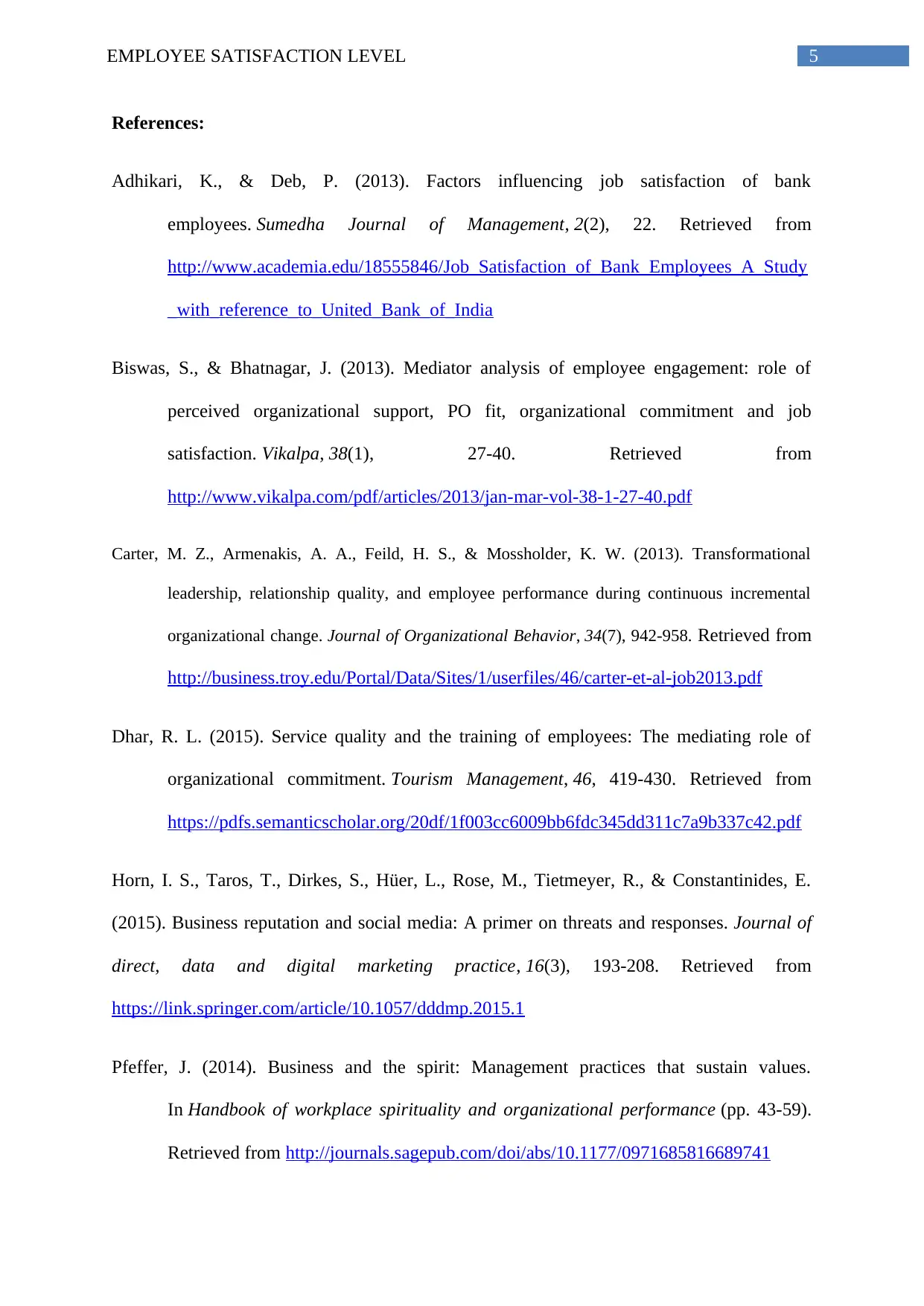
5EMPLOYEE SATISFACTION LEVEL
References:
Adhikari, K., & Deb, P. (2013). Factors influencing job satisfaction of bank
employees. Sumedha Journal of Management, 2(2), 22. Retrieved from
http://www.academia.edu/18555846/Job_Satisfaction_of_Bank_Employees_A_Study
_with_reference_to_United_Bank_of_India
Biswas, S., & Bhatnagar, J. (2013). Mediator analysis of employee engagement: role of
perceived organizational support, PO fit, organizational commitment and job
satisfaction. Vikalpa, 38(1), 27-40. Retrieved from
http://www.vikalpa.com/pdf/articles/2013/jan-mar-vol-38-1-27-40.pdf
Carter, M. Z., Armenakis, A. A., Feild, H. S., & Mossholder, K. W. (2013). Transformational
leadership, relationship quality, and employee performance during continuous incremental
organizational change. Journal of Organizational Behavior, 34(7), 942-958. Retrieved from
http://business.troy.edu/Portal/Data/Sites/1/userfiles/46/carter-et-al-job2013.pdf
Dhar, R. L. (2015). Service quality and the training of employees: The mediating role of
organizational commitment. Tourism Management, 46, 419-430. Retrieved from
https://pdfs.semanticscholar.org/20df/1f003cc6009bb6fdc345dd311c7a9b337c42.pdf
Horn, I. S., Taros, T., Dirkes, S., Hüer, L., Rose, M., Tietmeyer, R., & Constantinides, E.
(2015). Business reputation and social media: A primer on threats and responses. Journal of
direct, data and digital marketing practice, 16(3), 193-208. Retrieved from
https://link.springer.com/article/10.1057/dddmp.2015.1
Pfeffer, J. (2014). Business and the spirit: Management practices that sustain values.
In Handbook of workplace spirituality and organizational performance (pp. 43-59).
Retrieved from http://journals.sagepub.com/doi/abs/10.1177/0971685816689741
References:
Adhikari, K., & Deb, P. (2013). Factors influencing job satisfaction of bank
employees. Sumedha Journal of Management, 2(2), 22. Retrieved from
http://www.academia.edu/18555846/Job_Satisfaction_of_Bank_Employees_A_Study
_with_reference_to_United_Bank_of_India
Biswas, S., & Bhatnagar, J. (2013). Mediator analysis of employee engagement: role of
perceived organizational support, PO fit, organizational commitment and job
satisfaction. Vikalpa, 38(1), 27-40. Retrieved from
http://www.vikalpa.com/pdf/articles/2013/jan-mar-vol-38-1-27-40.pdf
Carter, M. Z., Armenakis, A. A., Feild, H. S., & Mossholder, K. W. (2013). Transformational
leadership, relationship quality, and employee performance during continuous incremental
organizational change. Journal of Organizational Behavior, 34(7), 942-958. Retrieved from
http://business.troy.edu/Portal/Data/Sites/1/userfiles/46/carter-et-al-job2013.pdf
Dhar, R. L. (2015). Service quality and the training of employees: The mediating role of
organizational commitment. Tourism Management, 46, 419-430. Retrieved from
https://pdfs.semanticscholar.org/20df/1f003cc6009bb6fdc345dd311c7a9b337c42.pdf
Horn, I. S., Taros, T., Dirkes, S., Hüer, L., Rose, M., Tietmeyer, R., & Constantinides, E.
(2015). Business reputation and social media: A primer on threats and responses. Journal of
direct, data and digital marketing practice, 16(3), 193-208. Retrieved from
https://link.springer.com/article/10.1057/dddmp.2015.1
Pfeffer, J. (2014). Business and the spirit: Management practices that sustain values.
In Handbook of workplace spirituality and organizational performance (pp. 43-59).
Retrieved from http://journals.sagepub.com/doi/abs/10.1177/0971685816689741
⊘ This is a preview!⊘
Do you want full access?
Subscribe today to unlock all pages.

Trusted by 1+ million students worldwide
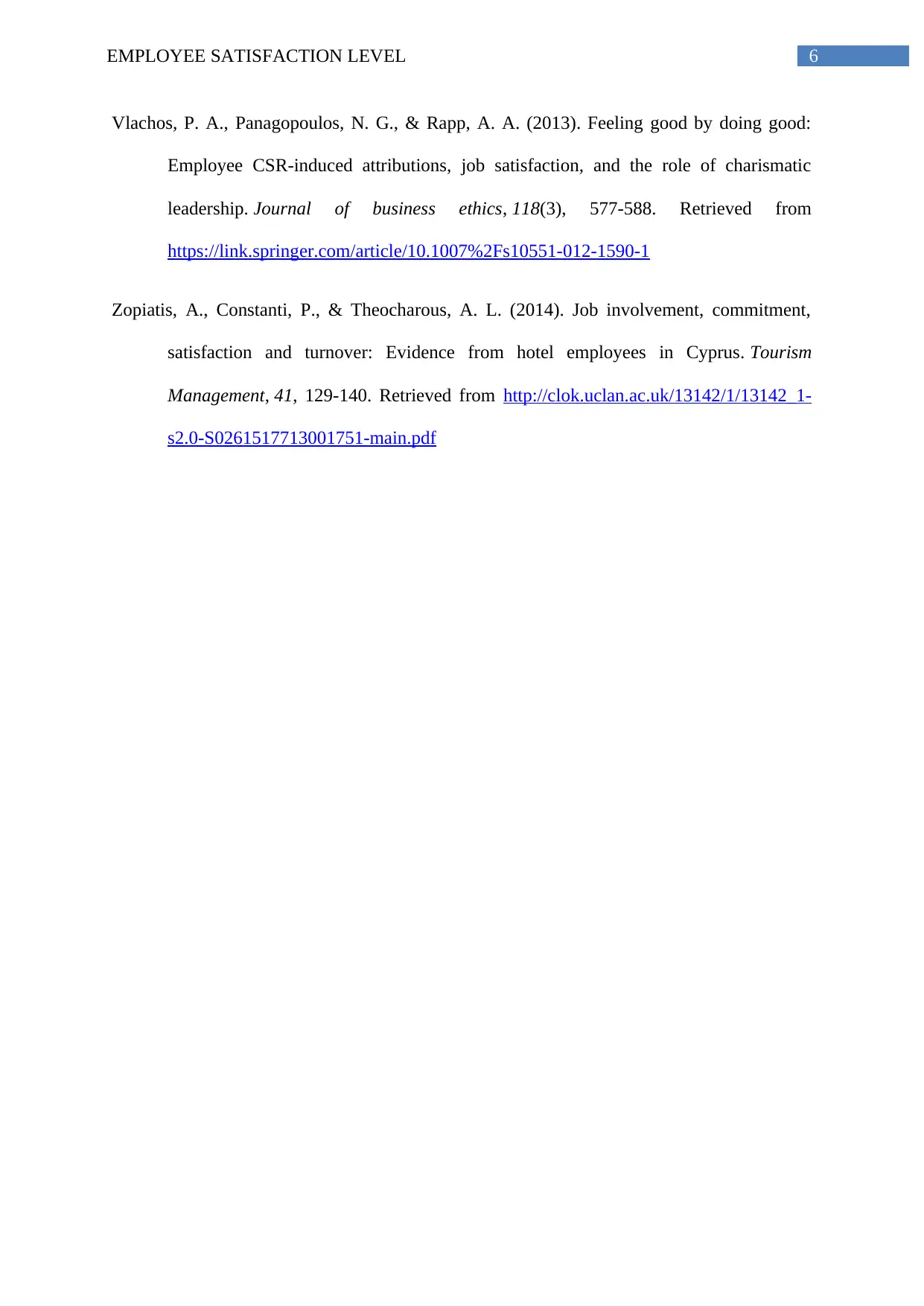
6EMPLOYEE SATISFACTION LEVEL
Vlachos, P. A., Panagopoulos, N. G., & Rapp, A. A. (2013). Feeling good by doing good:
Employee CSR-induced attributions, job satisfaction, and the role of charismatic
leadership. Journal of business ethics, 118(3), 577-588. Retrieved from
https://link.springer.com/article/10.1007%2Fs10551-012-1590-1
Zopiatis, A., Constanti, P., & Theocharous, A. L. (2014). Job involvement, commitment,
satisfaction and turnover: Evidence from hotel employees in Cyprus. Tourism
Management, 41, 129-140. Retrieved from http://clok.uclan.ac.uk/13142/1/13142_1-
s2.0-S0261517713001751-main.pdf
Vlachos, P. A., Panagopoulos, N. G., & Rapp, A. A. (2013). Feeling good by doing good:
Employee CSR-induced attributions, job satisfaction, and the role of charismatic
leadership. Journal of business ethics, 118(3), 577-588. Retrieved from
https://link.springer.com/article/10.1007%2Fs10551-012-1590-1
Zopiatis, A., Constanti, P., & Theocharous, A. L. (2014). Job involvement, commitment,
satisfaction and turnover: Evidence from hotel employees in Cyprus. Tourism
Management, 41, 129-140. Retrieved from http://clok.uclan.ac.uk/13142/1/13142_1-
s2.0-S0261517713001751-main.pdf
1 out of 7
Related Documents
Your All-in-One AI-Powered Toolkit for Academic Success.
+13062052269
info@desklib.com
Available 24*7 on WhatsApp / Email
![[object Object]](/_next/static/media/star-bottom.7253800d.svg)
Unlock your academic potential
Copyright © 2020–2025 A2Z Services. All Rights Reserved. Developed and managed by ZUCOL.





